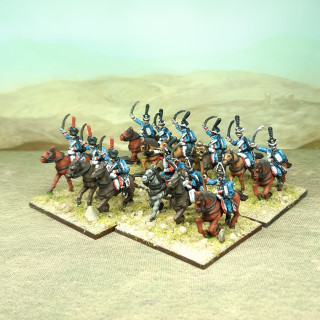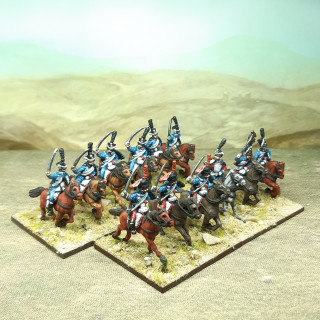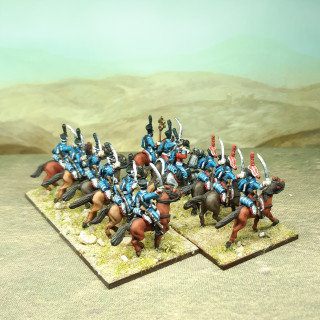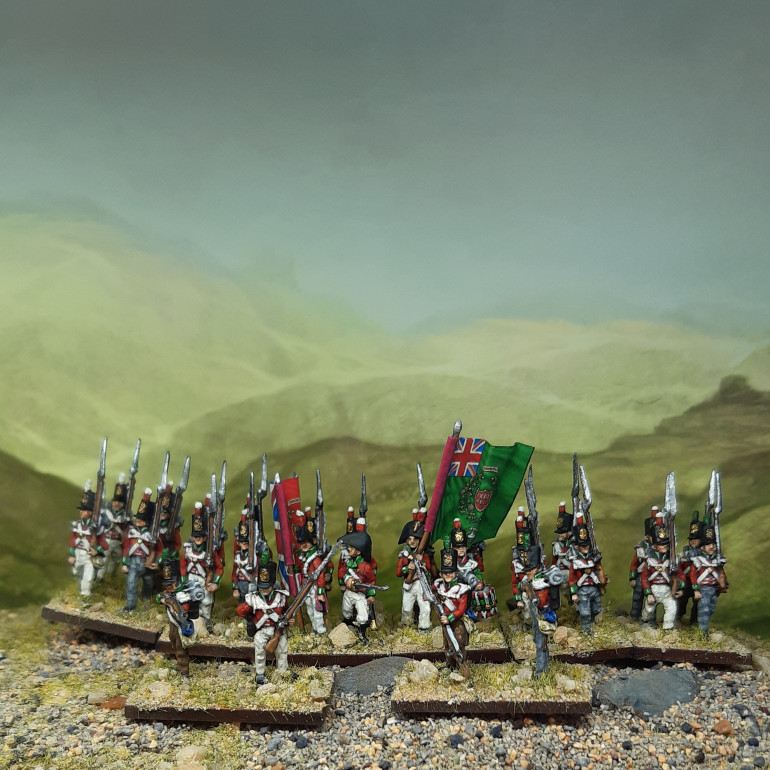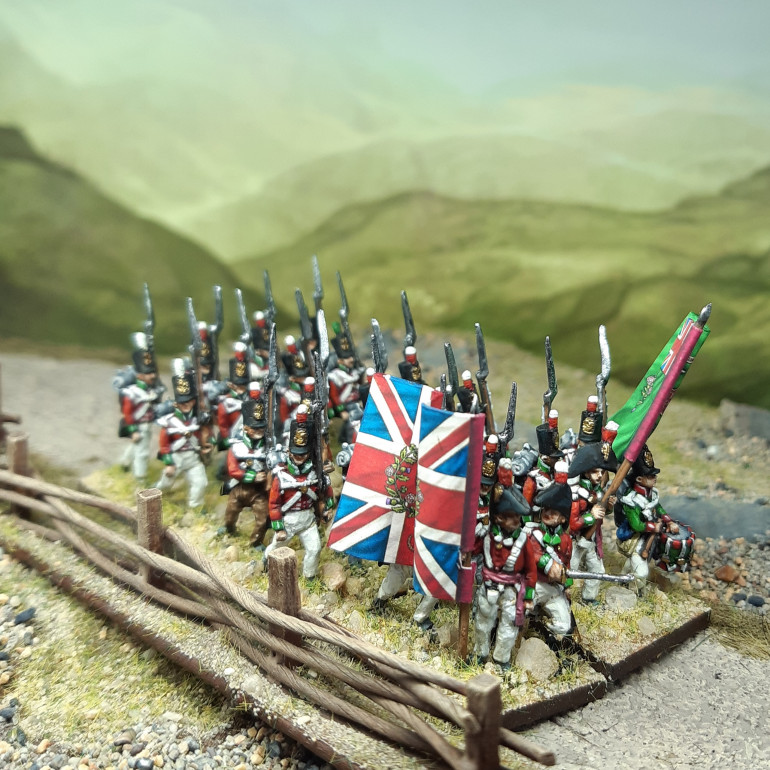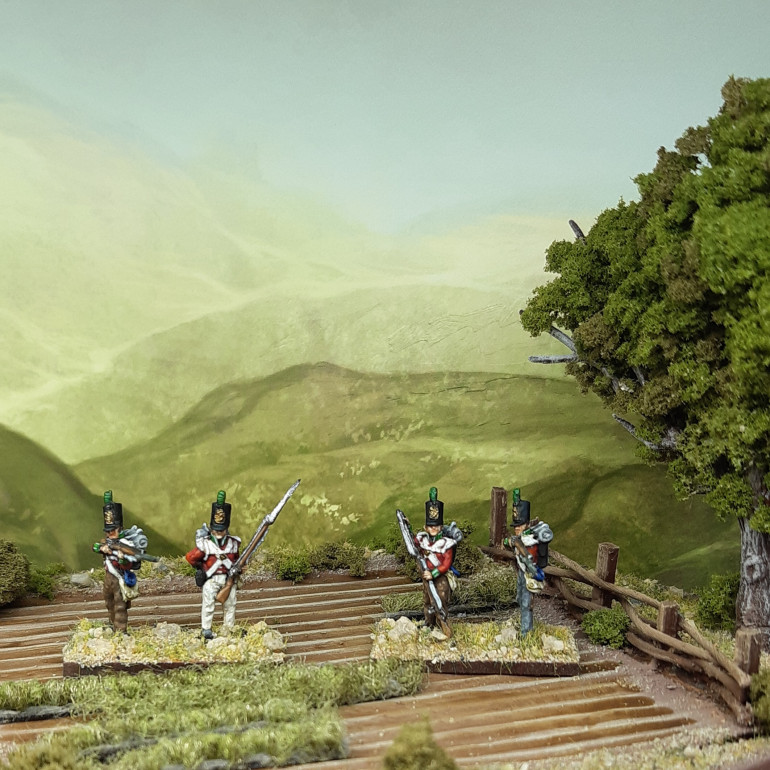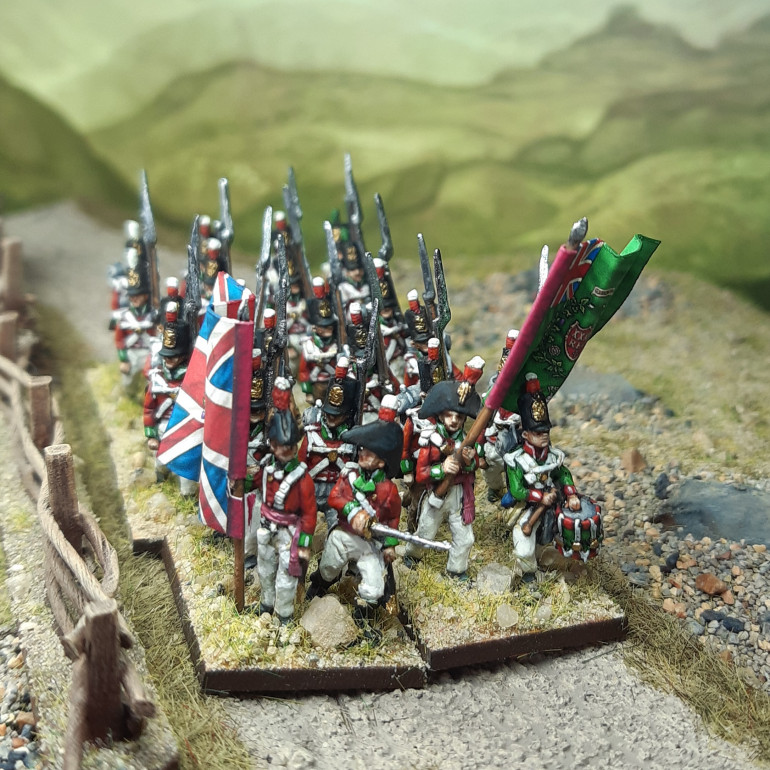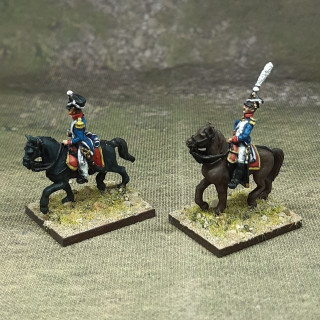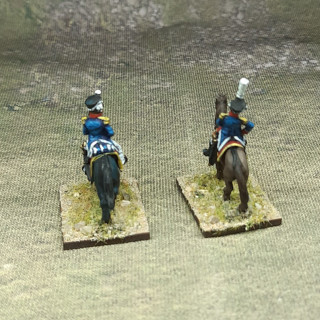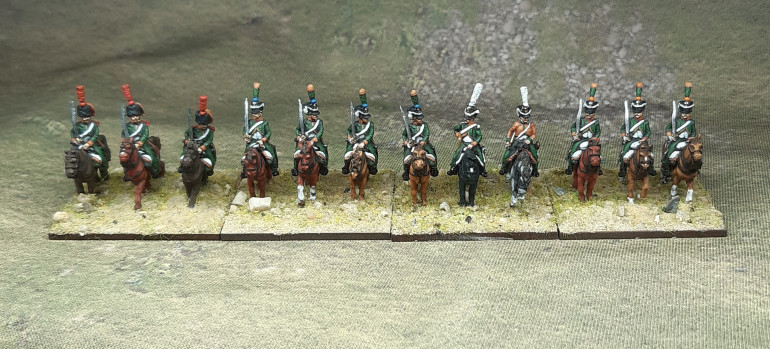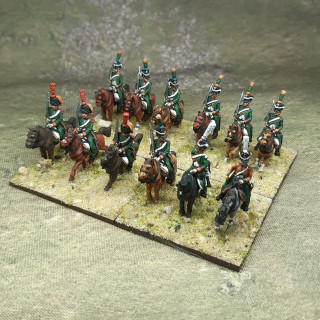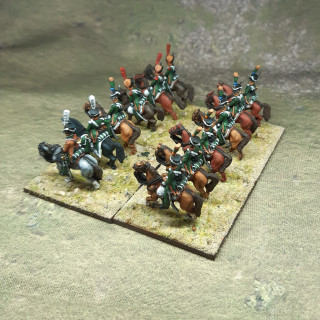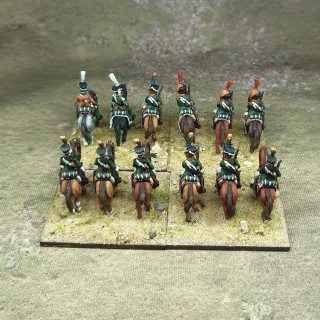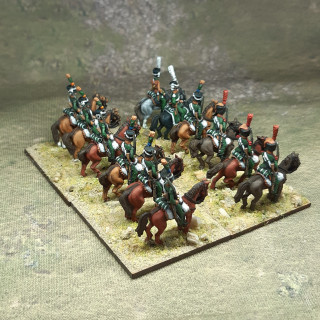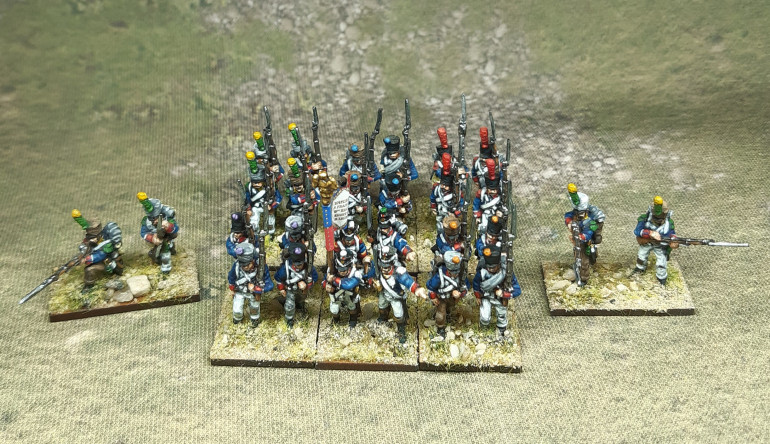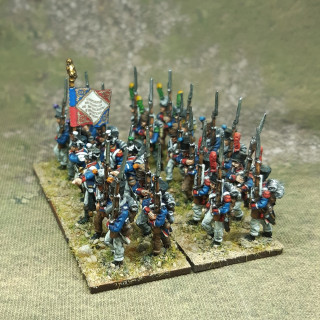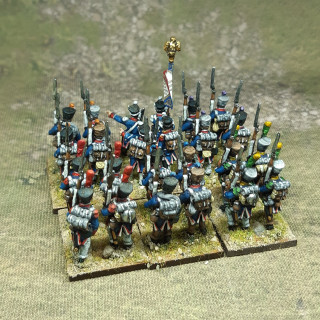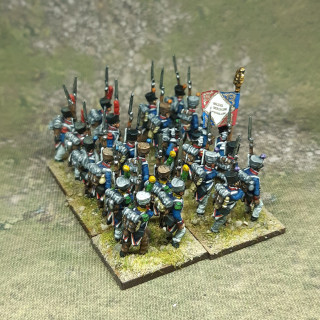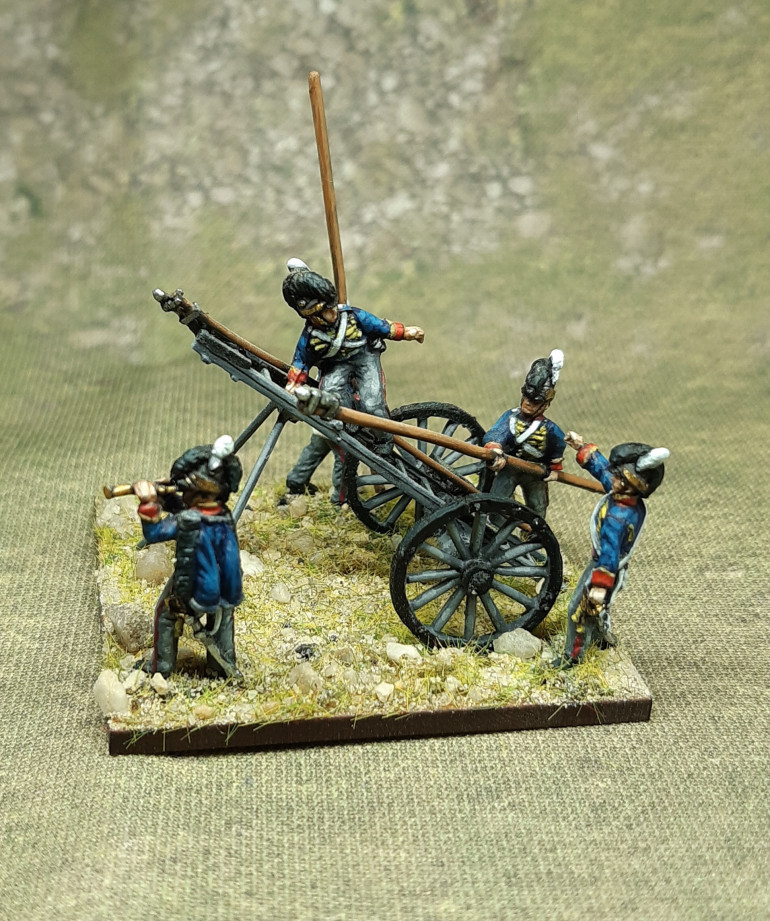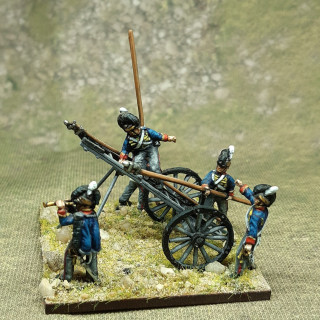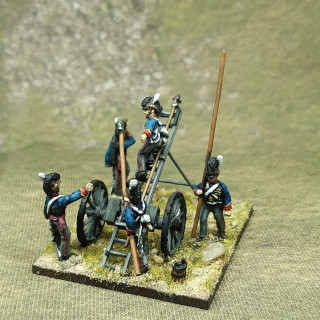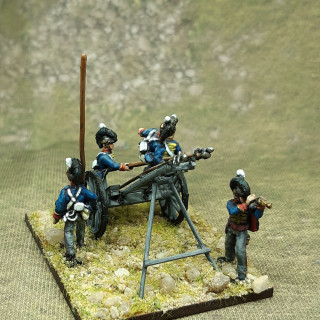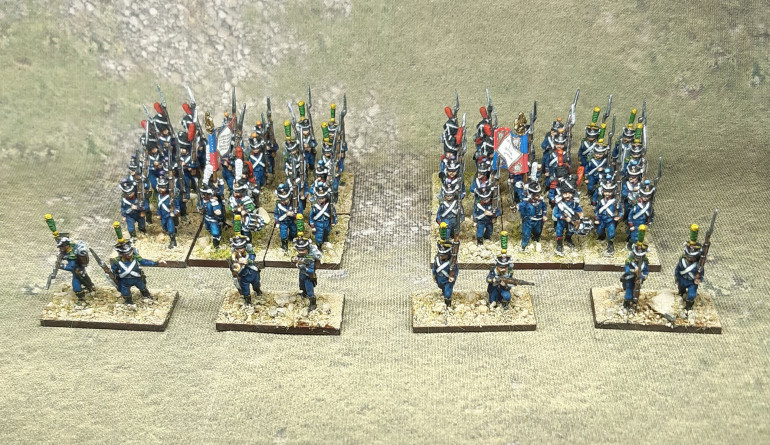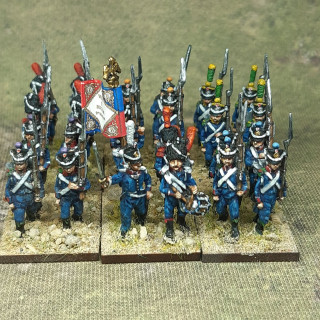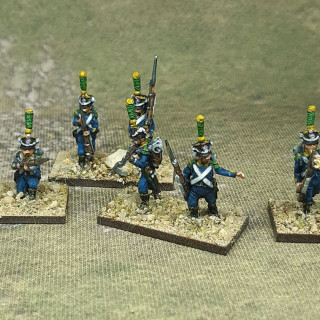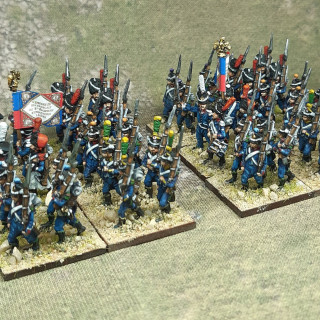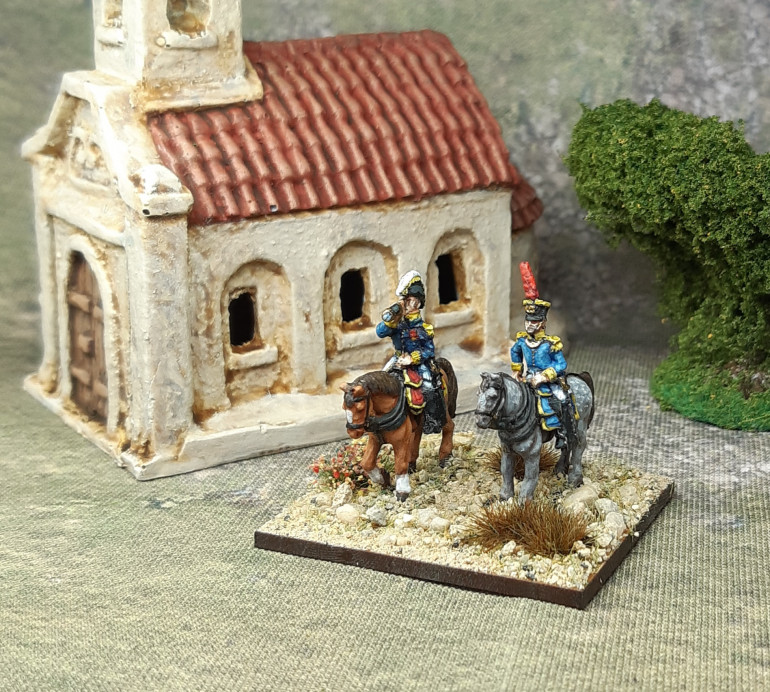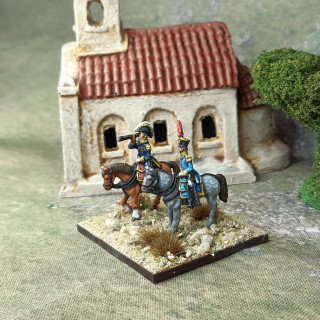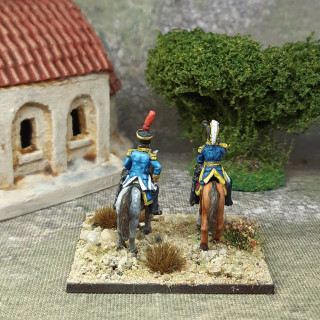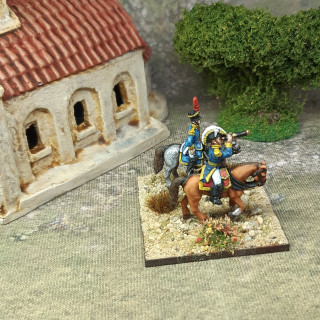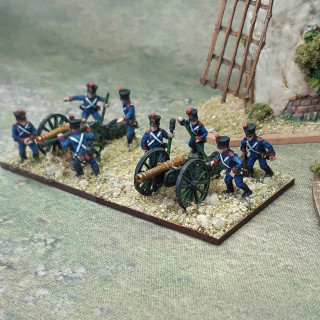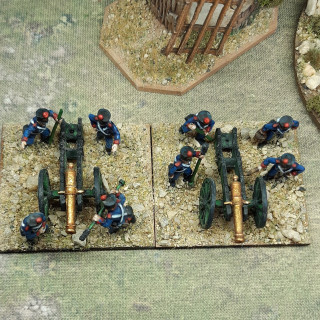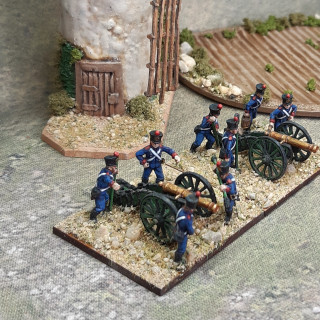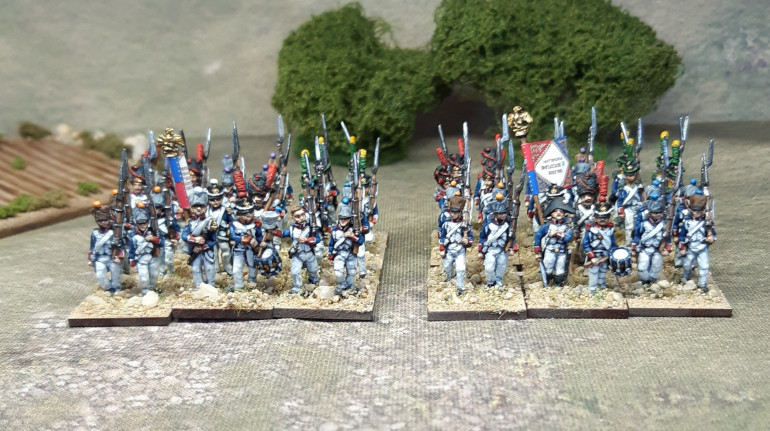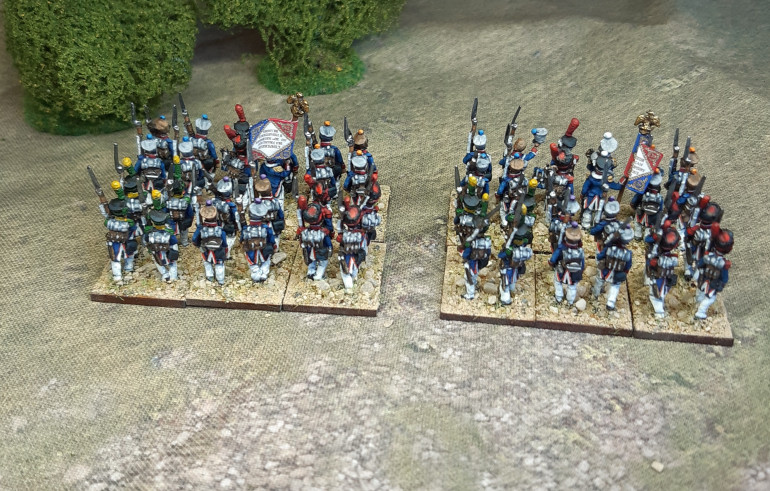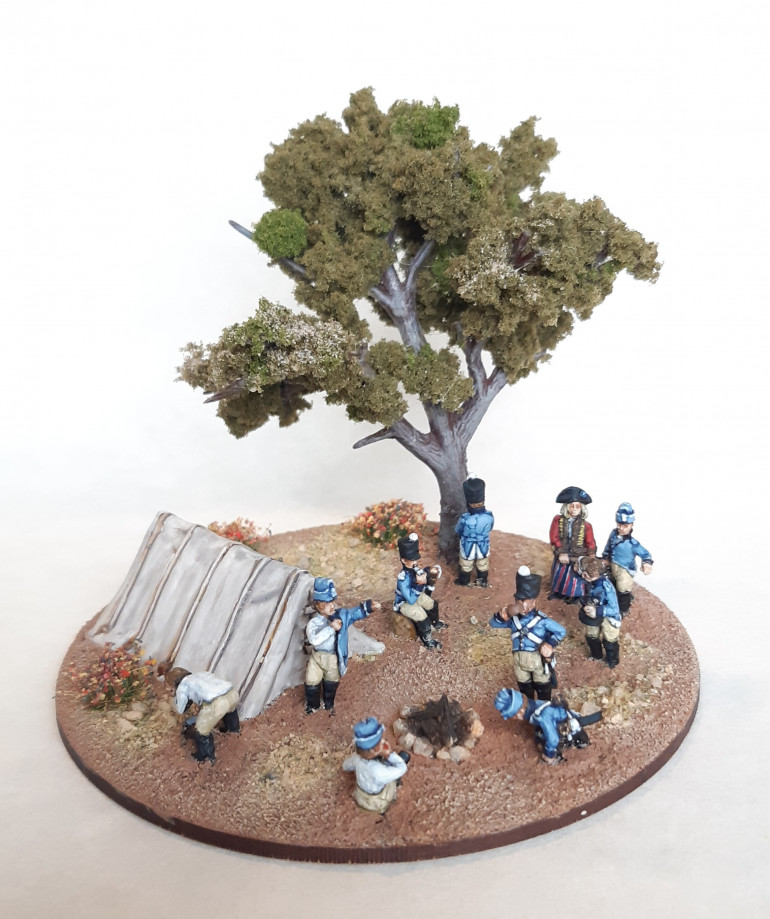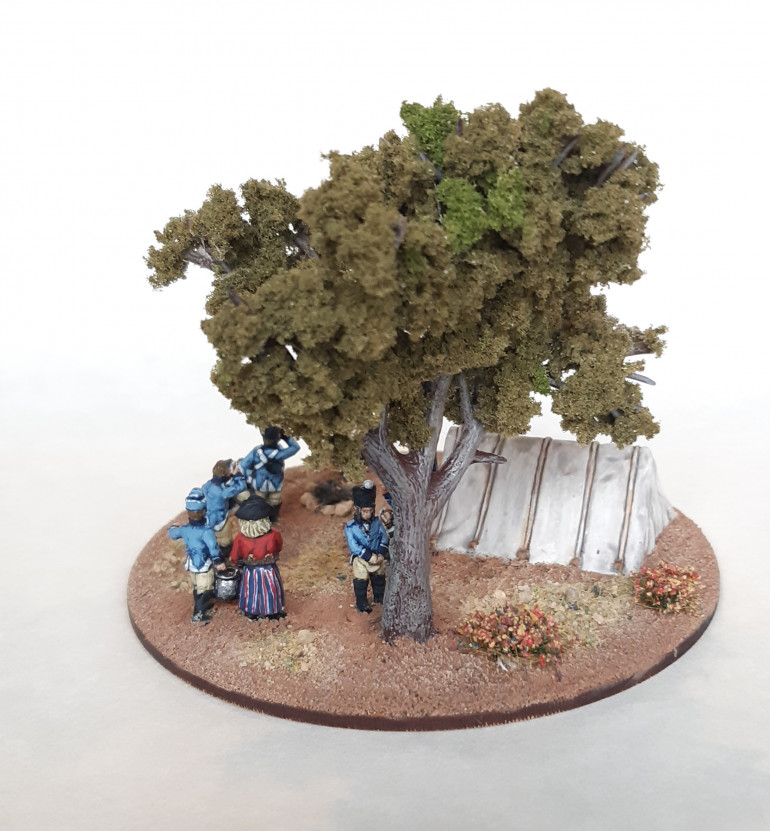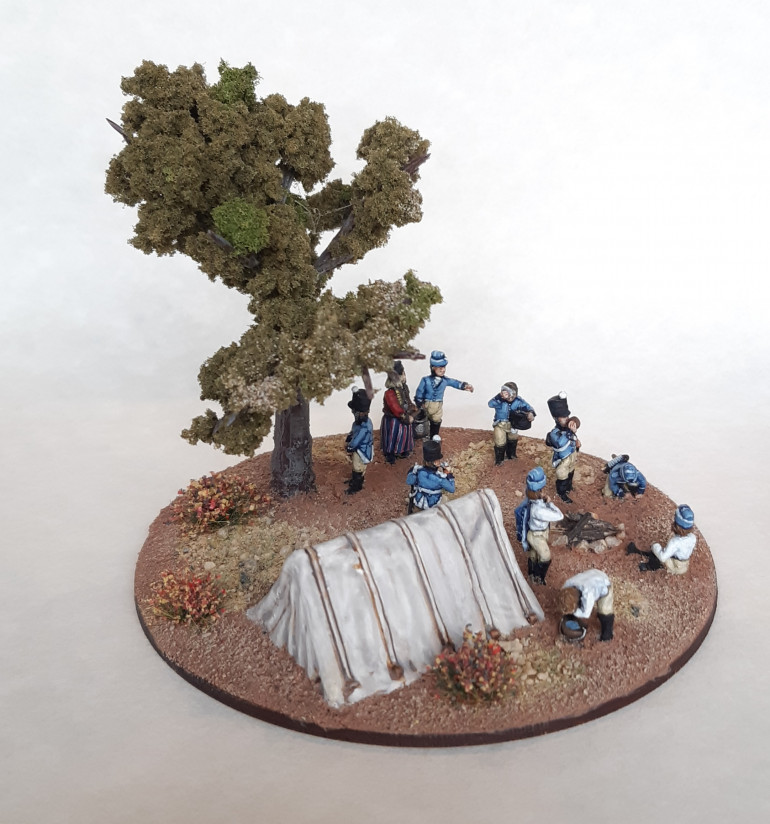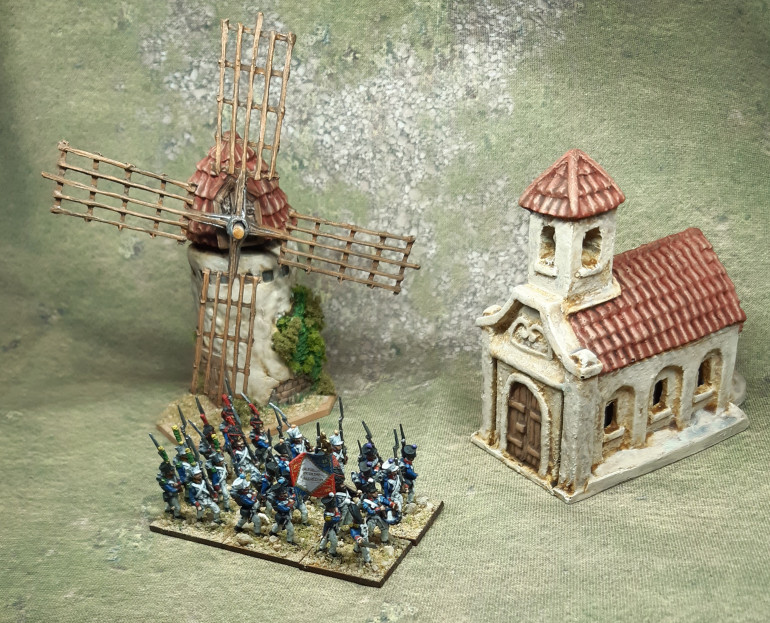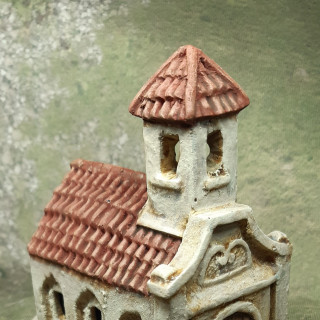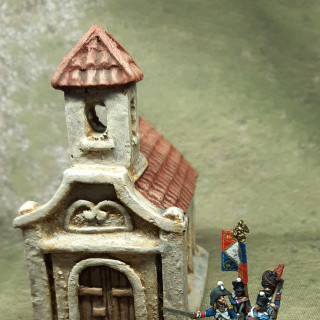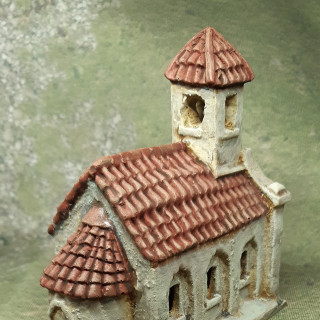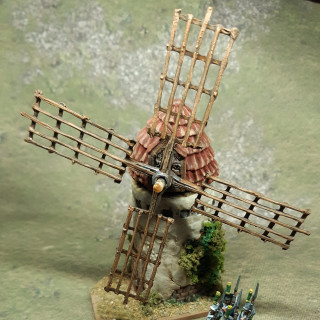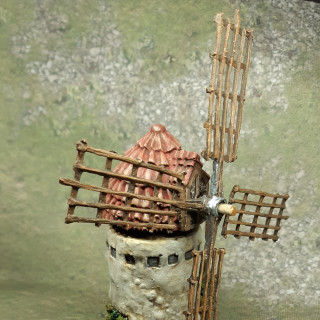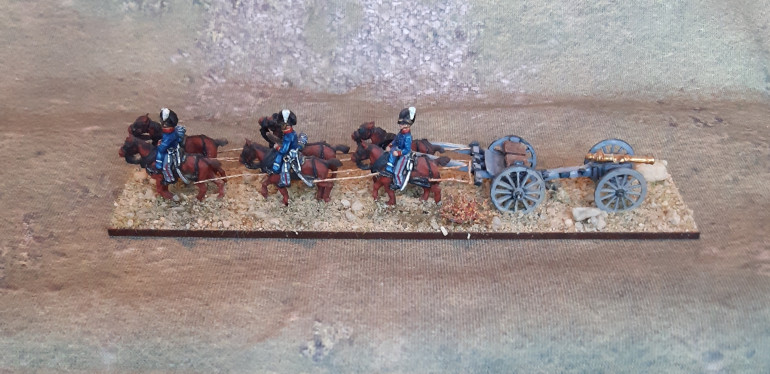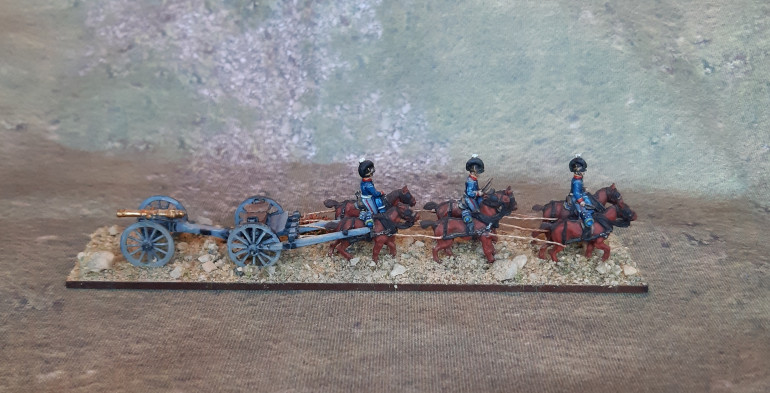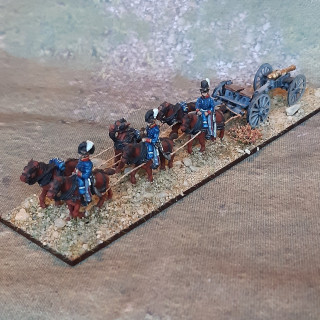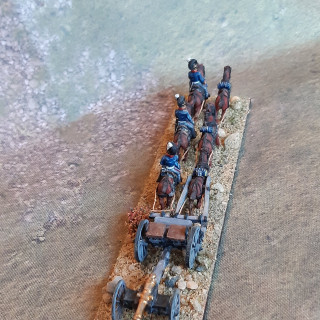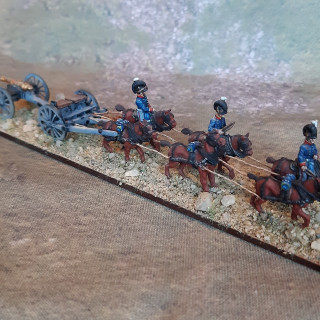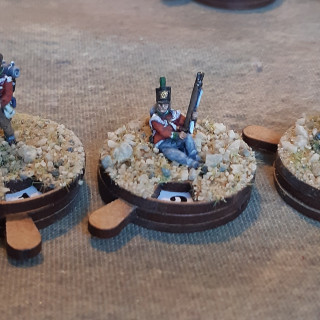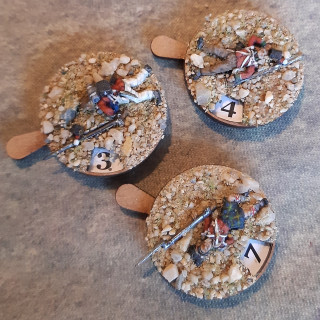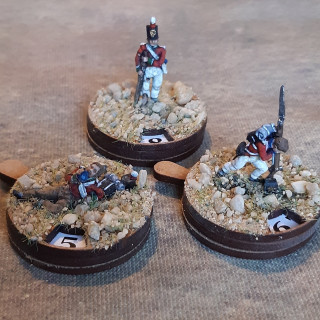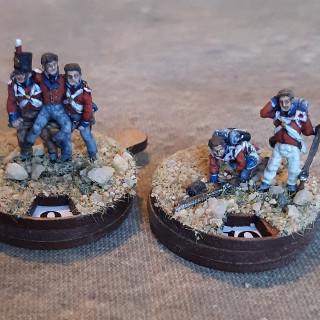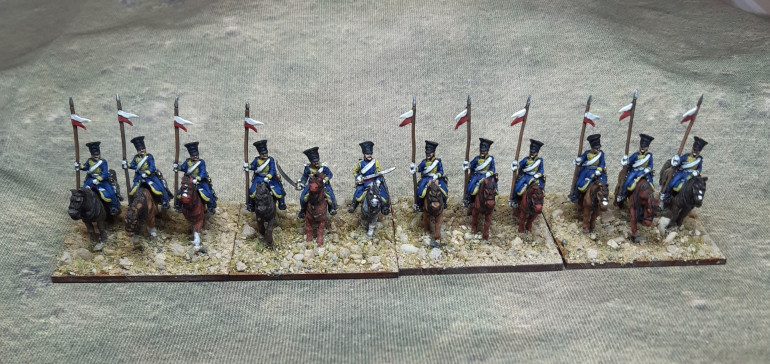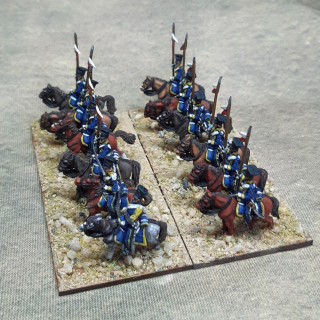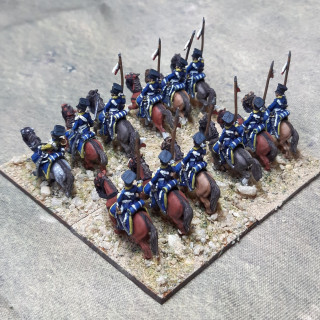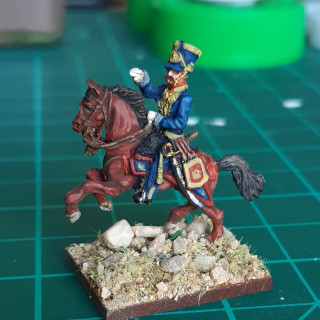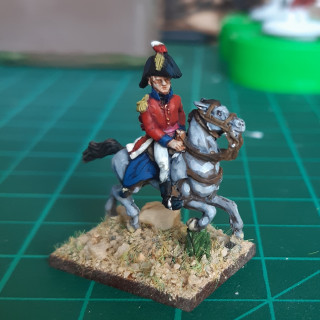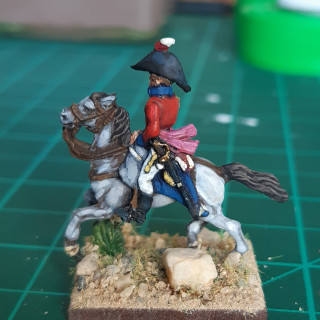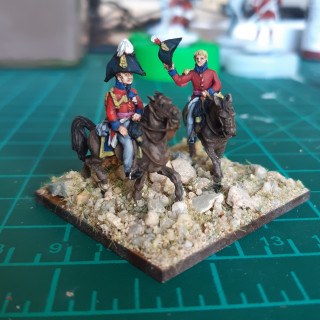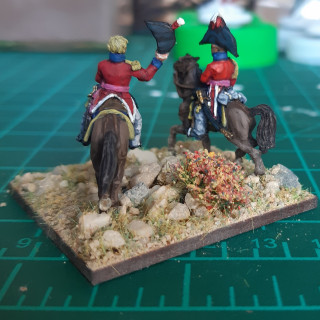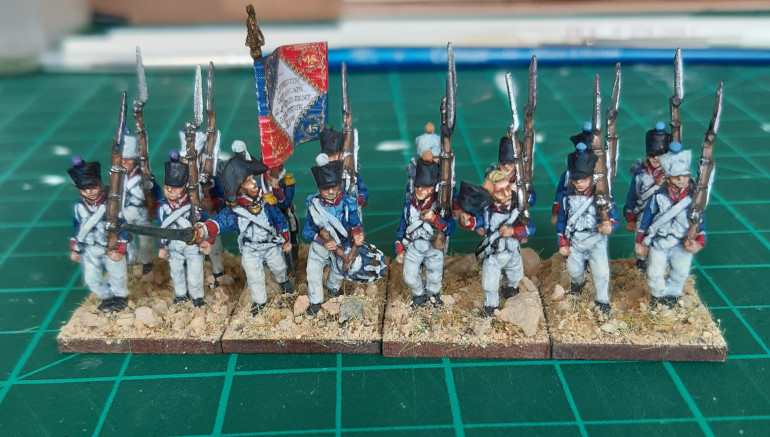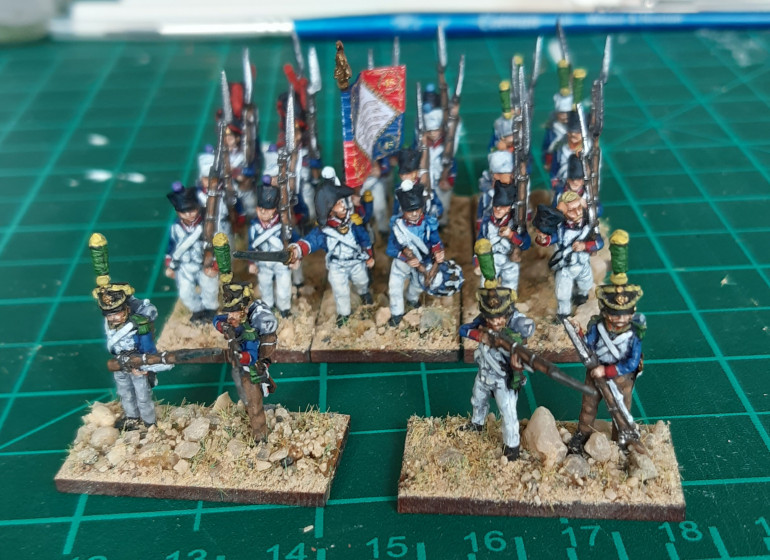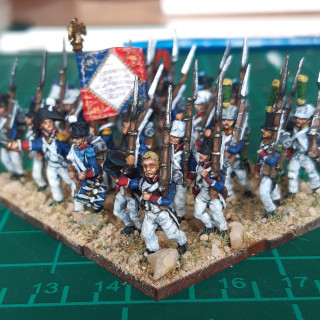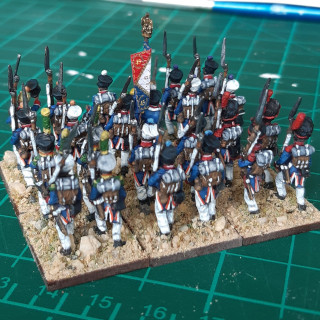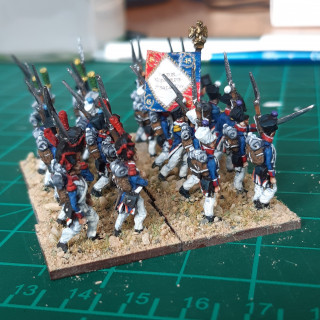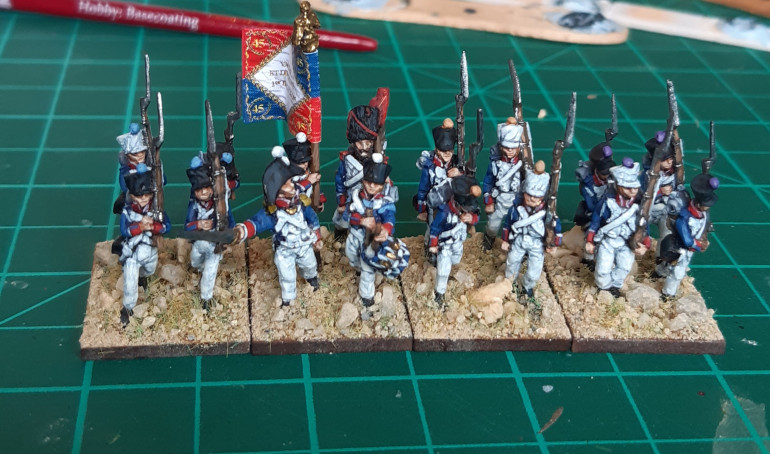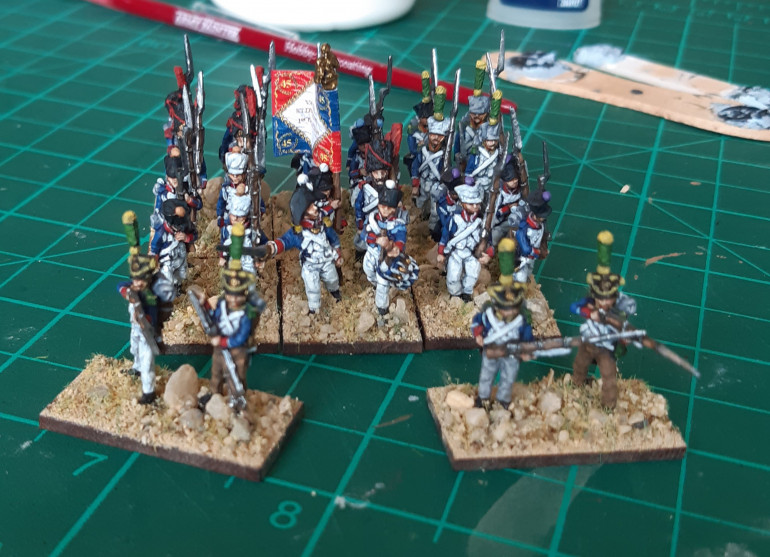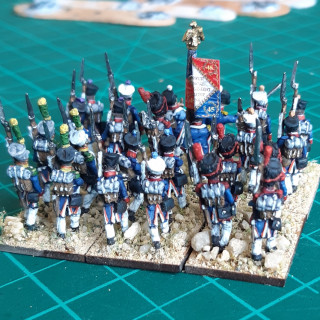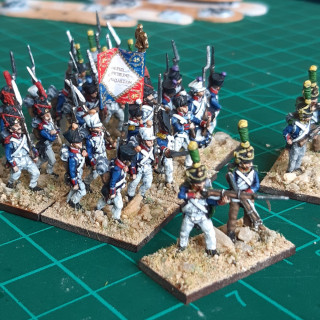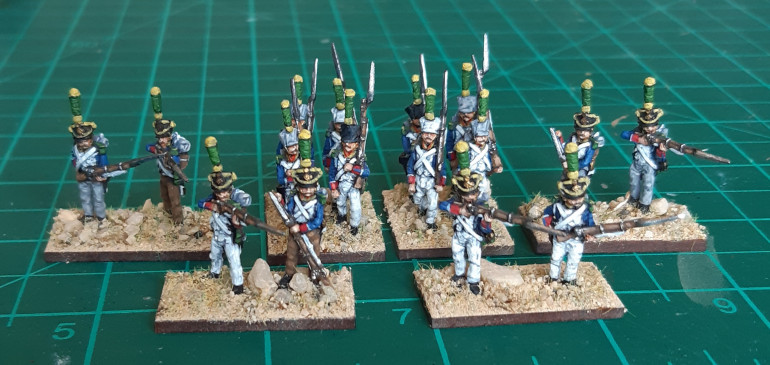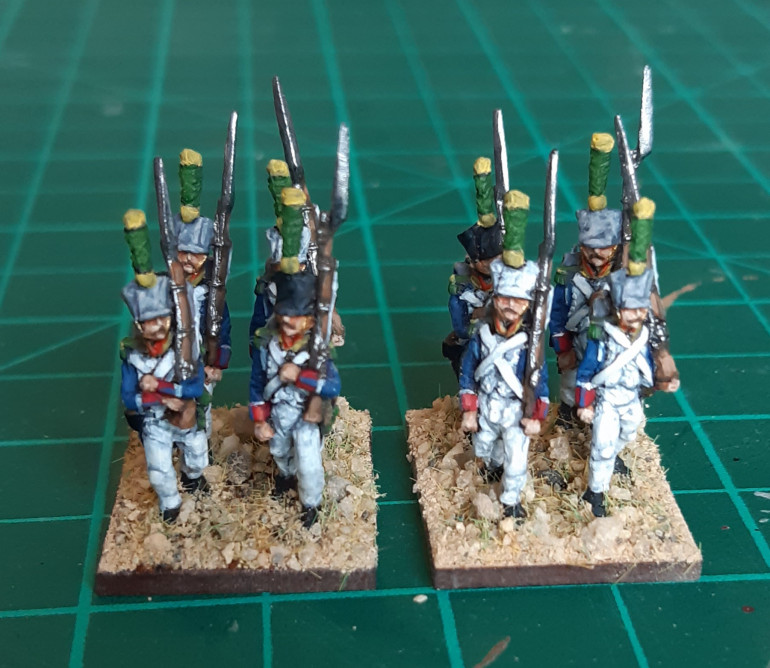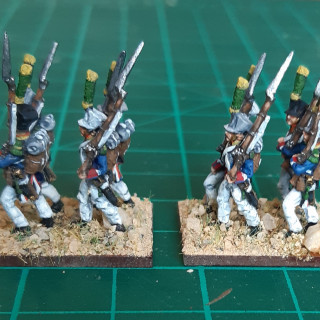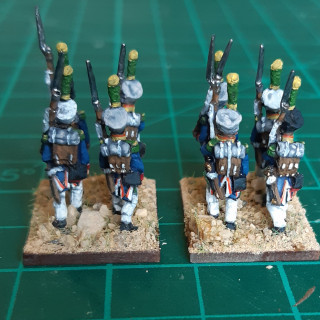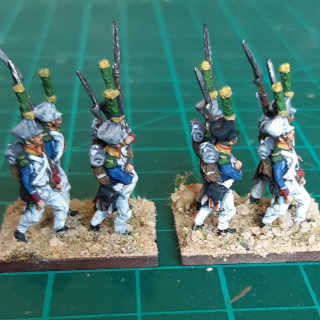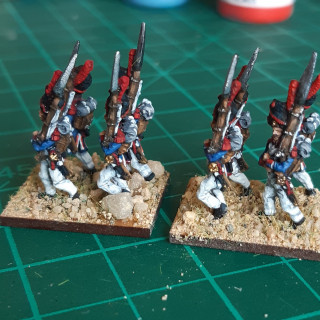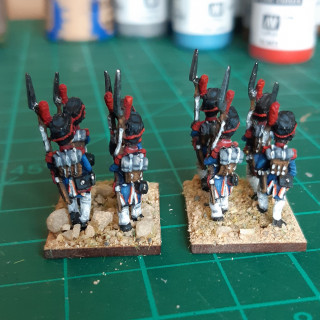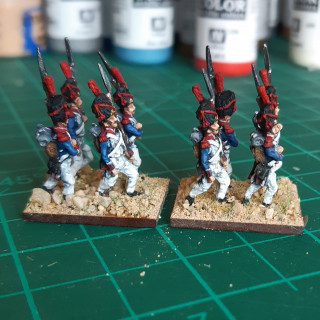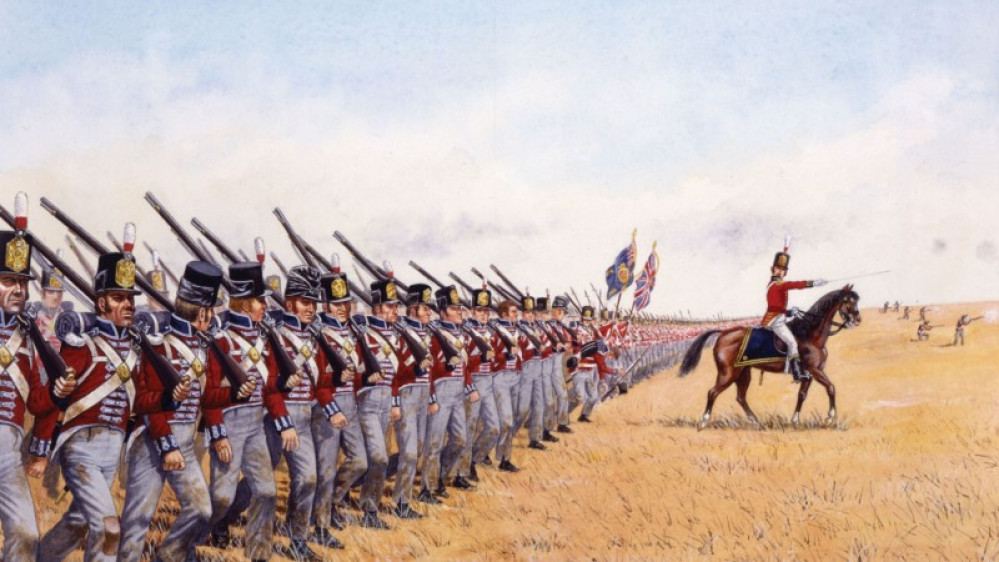
A Foray into Napoleonic Wargaming
Recommendations: 1631
About the Project
Documenting my progress on collecting and painting 15/18mm Napoleonic miniatures. This started with challenging myself to try my hand at painting miniatures at a smaller scale, and to look at a historic setting rather than fantasy or Sci-fi. I went for Napoleonics as I have an interest in the history of the period, there are some great ranges of minis, and there's a certain appeal in having painted blocks of Napoleonic troops. I'm not building a collection for any particular game system, or following an order of battle, this is very much about enjoying the painting. I tend to have limited hobby time and I'm also a slow painter, so this is a very slow burn project.
Related Genre: Historical
This Project is Active
1eme Hussars
It has again been quite a while since I added anything to this project, but I’ve added another lot of French light cavalry, this time some dashing Hussars.
I normally get my cavalry models from AB Figures, but their French Hussars are sculpted wearing buttoned up pelisses, rather than wearing them draped on the shoulder and flaring out at the charge. Instead, I picked up my figures from Xan Miniatures, who added a few French cavalry to their range at the end of last year.
I painted this lot as the first Hussars, who had a very impressive war record during the Napoleonic era. Before the Peninsula War, they fought at Marengo, Ulm, Austerlitz, Jena, Eylau, Heilsberg and Friedland. The first were with the Armées d’Espagne and du Portugal from 1808-1812 at Braga, Santillo, Sabugal and Monasterio, and won a battle Honour at Oporto. From 1813 they left the Peninsula, joining the Grand Armée in Germany.
The first aren’t the most elaborate Hussars in terms of their uniform, mostly sky blue with red cuffs, and a black trim to their pelisses. The elite Hussars add a bit more colour with red trousers, and the trumpeter wears reversed colours on the typical grey mount.
Not my best painting; feeling a bit rusty at painting this scale after doing a lot of 28mm stuff recently. However they look fine at gaming distance, and I’m pretty happy with the end result.
39th (Dorsetshire) Regiment of Foot
It’s been quite a while since I’ve added anything to my 15mm Napoleonic collection. I had a few spare British flank company figures, so grabbed a few more packs to get a red coat battalion up to strength.
I painted this lot as the 39th Regiment of Foot. The 39th were originally an Irish regiment raised in 1689, becoming the 39th Regiment in 1751 in the line infantry order of precedence during the reorganisation if the British army at that time. A county affiliation with Middlesex was established in 1782, which was switched to Dorsetshire in 1807.
The Regiment served across the globe, from Ireland to the Caribbean, Gibraltar to India; indeed they were the first British Regiment deployed to India, giving them the motto ‘Primus in Indis’.
In terms of the Napoleonic Wars, the 39th had a first battalion that served in the Caribbean, Malta and Sicily. A second battalion was raised in 1803, which was deployed to the Peninsula in 1809, fighting at Talavera, Bussaco, Badajoz and Albuera.
The first battalion joined Wellington’s army in the Peninsula in 1811, absorbing the battered survivors of the second battalion, whose officers returned home to recruit. The first fought at Vittoria, and crossed the Pyrenees into France. In 1814 they were sent to Canada to join the War of 1812 against America.
All the figures are from Xan Miniatures, with flags from GMB Designs.
French Officers
A couple of officers to keep my French organised. Both models are by AB Miniatures.
22eme Chasseurs a Cheval
The Chasseurs a Cheval were the work horses (no pun intended) of the French light cavalry. Less flashy than the hussars, but undertaking the same light cavalry roles such as reconnaissance, scouting, screening the army.
Each regiment of Chasseurs was formed of eight squadrons, the first of which was the elite squadron. These chaps had red plumes and epaulettes, and wore a colpack rather than a shako. Reforms to uniform in 1812 theoretically retired the colpack, but most regiments chose not to comply and retained them.
I chose to paint these as the 22eme regiment. The regimental colour is caupacine, a burnt orange-brown, which I honestly struggled to get a good match for. The 22eme served throughout the Peninsula War, often split down with squadrons spread between different formations. Their combat record included Medina-del-Rio-Seco, Niou, and the cspture of Burgos, Hoya, Benavente, Pont-Vedra, Astagora, Sabugal, Arapiles, Pancorbo, Torquemada, Burgos and Vittoria.
These models are all by AB Miniatures.
3rd Battalion, 39eme Regiment de Ligne
Finished up another batch of French line infantry, representing the 3rd battalion of the 39eme regiment. Not much to add that hasn’t been written previously under the entry on the 1st & 2nd battalions of the same regiment.
These models are however from a different range, being some of Fizzer Johnson’s Men of Metal. These are all in campaign dress, with extra details like worn and patched clothes, and various extra blankets and items on backpacks etc. They match very well alongside the Xan models, and I quite like them as an alternative that adds a bit more variation. The flag comes from GMB Designs as per usual.
Plans for this project in 2023 is to add a couple of French light cavalry regiments and some officers, with the possibility of battle reports trying out Soldiers of Napoleon.
RHA Rocket Troop
A short pause in painting the French, but staying with blue jackets, with a British Royal Horse Artillery rocket troop.
Congreve rockets first saw operational service in 1805 by the navy. Rockets were classed by weight, with 32-pr and 16-pr being the most common. The 32-pdr rockets were used for bombardment purposes, whilst the 16-pr were used as field pieces. The Royal Navy were the main users, and the Royal Marine Artillery became experts in their use.
The Royal Artillery were reluctant to become involved with rockets, but came under pressure from the Prince Regent to incorporate them. Various rocket detachments served as part of the RHA in the Peninsula War, eventually forming 1st and 2nd Rocket Troops in 1815. The foot artillery were never involved with rockets.
The rocket brigade were the only British troops that fought in the Battle of Nations at Leipzig in 1813, detached to serve with the Swedish army.
These models are from a new range of 18mm Napoleonics, Fizzer Johnson’s Men of Metal, and are very nice sculpts. They fit in well alongside AB, and have a good level of detail. Will definitely be adding a few more from this range to my collection.
6eme Regiment de Legere
They took a little while to finish, but I finally got two battalions of light infantry completed for my Peninsula French. These battalions are part of the 6eme Regiment de Légere.
The 6eme received a fair few distinctions for their actions in the Peninsula. They formed part of the Army of Portugal, first under Massena, and then Marmont, brigaded with the 39eme Line Regiment. Volunteers from the 6eme were the first through the breeches in the siege of Ciudad Rodrigo in 1810. They also fought at Almeida, Busaco and Fuentes-de-Onoro, and formed part of the rear guard after Salamanca. The regiment was redeployed from Spain to Germany after Napoleon’s disastrous expedition into Russia.
Like the line infantry, the structure of light infantry battalions was re-organised in 1808, each being composed of six companies. There were four centre companies, with the basic soldier being a chasseur, and two elite companies, one of Voltigeurs, and one of Carabiniers. The main differences in uniform between line and light infantry to capture for the Peninsula Campaign are the blue trousers as opposed to the white of the line, and the Hungarian style gaiters with coloured knots.
There are some inaccuracies with how I’ve portrayed these units, starting with the Eagles carried by both battalions, when in fact neither should have them. Light infantry regiments were only issued with a single Eagle, and in 1807 all light infantry regiments were instructed to leave their Eagles at their home depot. I also very much made up the uniform of drummer, having found it very hard to find any solid information on what the colours and patterns should be. My carabinier companies have bearskins; according to uniform regulations of the time, carabiniers were not issued bearskins, but there’s plenty of depictions of them wearing them, so I decided to include them.
Once again, all models are by Xan, and flags by GMB Designs.
French General
I needed to add in some command element for my French, so painted up a General d’Division with Aide de Camp. Both come as a joint pack from Campaign Game Miniatures. I quite like the character of the General with his telescope surveying the battlefield, with the ADC ready to convey orders as required.
Artillerie à Pied
Added some support for the French infantry with a batter of foot artillery.
The French artillery was quite formidable, often used very aggressively and offensively compared to the more defensive deployment of allied guns.
The foot artillery probably has the simplest uniform to paint. It’s pretty much all dark blue, bar the red cuffs, shoulder straps, collar edging and turnbacks, and black gaiters. Gun carriages are a olive green. Possibly a nice place to start if you are new to Napoleonics to ease you in a bit.
These models are all from Campaign Game Miniatures.
39eme Regiment de Ligne
I’ve been slowly painting up some more French line infantry over the last couple of months, specifically the 1st and 2nd battalions of the 39eme Line Regiment.
The 39eme formed part of the French Army of Portugal, first under Massena, and then Marmont. They participated in quite a few of the major battles between 1810-13, including Cuidad-Rodrigo, Coa River, Almeida, Busaco and Torres -Vedras, Fuentes-d’Onoro, Almaraz, Nivelle and Bayonne. They were redeployed to Germany in 1813 to fight against the sixth coalition.
Models are again all by Xan, with flags by GMB flags.
Managed to mess up and add one of the flags upside down, which I realised far too late. Whilst I can probably fix it, I’m leaving for the moment as a reminder to pay more attention to what I’m doing in the future!
French Camp
Quite a few Napoleonic ranges do some incidental miniatures for putting together camp scenes or ancillary support like hospitals or baggage trains. I came across this nice camp set by Eureka Miniatures, and thought a little camp scene could be fun to make, plus could act as an objective marker or something. The tent is a resin cast by Debris of War.
If you’re looking at this and thinking that the soldiers don’t look like French infantry, you’d be right. They are a group of artillery train drivers, wearing a single breasted Kinski coat, which wasn’t very common across the French army.
Church & Windmill
A couple of resin buildings to decorate the table, both from Hovels. I’ve had these for a little while, but I was a little disappointed with the number of bubbles on the casts, particularly on the roof tiles, with the windmill being worse than the church, so I had been putting off painting these. Whilst I patched some of the worst gaps, there was no way I was going to deal with all the roof tiles.
These are fast and sloppy painting efforts, as I didn’t want to spend much time on them. However, with a bit of paint, I don’t think they look as bad as I had feared.
RHA Limber
Inspired by seeing Nightrunner’s fantastic 1/72 French army for DBN (check out the project here https://www.beastsofwar.com/project/1693277/) I decided to get a few more things painted for this project.
This is a British Royal Horse Artillery limber with a 6lb cannon. The RHA team and limber are by AB Miniatures, whilst the cannon is by Xan.
The tracers were made from salvaged plug flex, stripped back to get at the wires, with three strands twisted together and snipped to size. Like rigging Age of Sail ships, not an essential step, but adds to the finished look.
British Causalty Markers
A set of casualty figures from AB Miniatures based on dials made by Warbases.
A very characterful set of walking wounded and those less fortunate, although I did have to find my tartan paint again for the Highlander.
1st Vistula Lancers
During the Napoleonic wars, there were a number of different nationalities that fought alongside the French, some willing, others bound by treaty. Amongst the different satrapies, client kingdoms, allies and foreign regiments that fought under French colours, the Poles formed a substantial component of the Grand Armee. With Poland wholly partitioned between Prussia, Russia and Austria in 1793, Napoleon positioned himself as the only man capable of restoring Polish sovereignty. In 1807 the Duchy of Warsaw was formed after the Treaty of Tilsit, creating a Polish client state of the French Empire. A lot of Polish soldiers in French service were reformed under the army of the Duchy, but there still remained some Poles that served under French colours. The Vistula Legion was one of these, formed in 1808 after re-organisation of the Polish-Italian Legions. The Vistula Legion was comprised of both infantry and cavalry regiments, but during its formation second staff section as added, allowing the cavalry and infantry to operate independently. Indeed, despite both the Vistula infantry and cavalry being deployed to the Peninsula, they never served together on the same battlefield throughout their service.
The cavalry component of the Vistula Legion was comprised of two lancer regiments. They spent four years fighting in the Spanish Peninsula, and by and large, were extremely successful in the majority of their confrontations against the Spanish, British and Portuguese. Their most famous engagement was the at Albuera in 1811, were the 1st Vistula Lancers formed part of Soult army as they clashed with a Spanish and Anglo-Portuguese force lead by Beresford. Supported by the 6th Hussars, the Vistula lancers initially spearheaded a feint against the allies around the village of Albuera, before galloping across the front of French army to join the real French attack on the allied lines, a sweep around Beresford’s right flank. As the allies shifted to meet the advancing French columns, Colborne’s Brigade were exposed with an unsupported flank, which the Vistula lancers ruthlessly exploited. Helped by an initial misidentification as Spanish cavalry, the lancers were able to ride over three British battalions (1/3rd, 2nd/66th and 2/48th) caught out of square formation, inflicting huge casualties and capturing 4 or 5 colours, and 5 cannon from a supporting KGL artillery battery. The 31st regiment were able to form square and thus save themselves. Although Albuera was an eventual French defeat, it was one of the bloodiest battles of the Peninsula campaign.
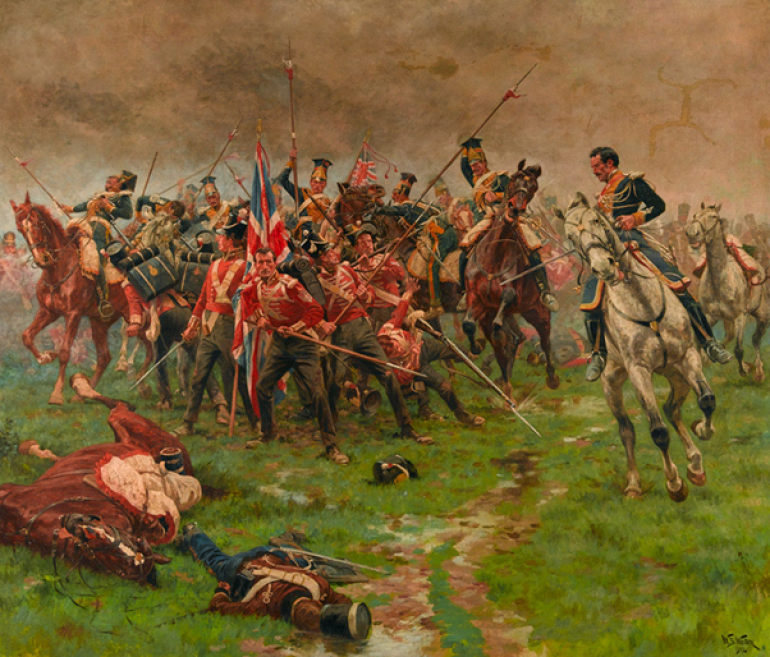 The 3rd Regiment of Foot defend their colours against the Vistula Lancers at Albeura. Painting by William Barnes Wollen
The 3rd Regiment of Foot defend their colours against the Vistula Lancers at Albeura. Painting by William Barnes WollenAfter Albuera, Napoleon made a decision to transform six of his dragon regiments into light horse lancers, no doubt in part due to the success of the Vistula Lancers. As part of that decree, Napoleon also transformed the 1st and 2nd Vistula Lancers to regular troops of the French army, becoming the 7th and 8th Light Horse Lancer Regiments. The 1st/7th Lancers left the Peninsula in 1812 to participate in the ill-fated invasion of Russia.
The models are all from AB Miniatures. They are modelled with covers on their czapka, so there’s no yellow colour on the top. They also have plain saddlecloths as opposed to white sheepskins with yellow dog’s teeth patterning. I found about a 50/50 mix between sources having the lance pennons red over white vs white over red, and one picture had both at the same time.
British Officers
A pair of British Officers and ADCs by AB Miniatures. These are from a set designed for Waterloo, with two of the figures being Hill and Uxbridge.
Rowland ‘Daddy’ Hill served throughout the Peninsula Campaign, acting as a brigade commander during Moore’s ill fated campaign from 1808-9, and then as a divisional commander under Wellington from 1809, finally being entrusted with independent corps commands from 1811 to the end of the Peninsula War in 1814. The nickname of ‘Daddy’ Hill came from the fact he endeavoured to look after his men, and was in turn beloved by them.
Henry William Paget, the 1st Marquess of Anglesey, later the Earl of Uxbridge from 1812, had a far shorter Peninsula service record. He also served in Moore’s campaign, and as the commander of the British cavalry showed his leadership skills with victories over the French at Sahagun and Benavente in 1808, and demonstrated skillful handling of the British cavalry during the retreat to Corunna in 1809. He never returned to the Peninsula, as he eloped with Wellington’s sister in law, naturally making it impossible to serve alongside him. Stapleton-Cotton took his place as the cavalry commander in the Peninsula, and indeed Uxbridge only served at Waterloo due to the insistence of the Prince Regent.
2/45eme Regiment de Ligne
Another batch of Fusiliers and a command group have been finished, which means the second battalion of the 45eme is ready to join the first.
The second battalion was deployed alongside the 1/45eme for the majority of the Peninsula War, but it 1813 it was redirected to Germany after the disaster experienced by the Grand Armee in Russia. In Germany the 45th was charged with securing lines of communication, garrisoning strongholds and surveying the coasts.
All the models here are again by Xan, and the flag by Maverick Models. I particularly like the enthusiastic chap raising up his shako.
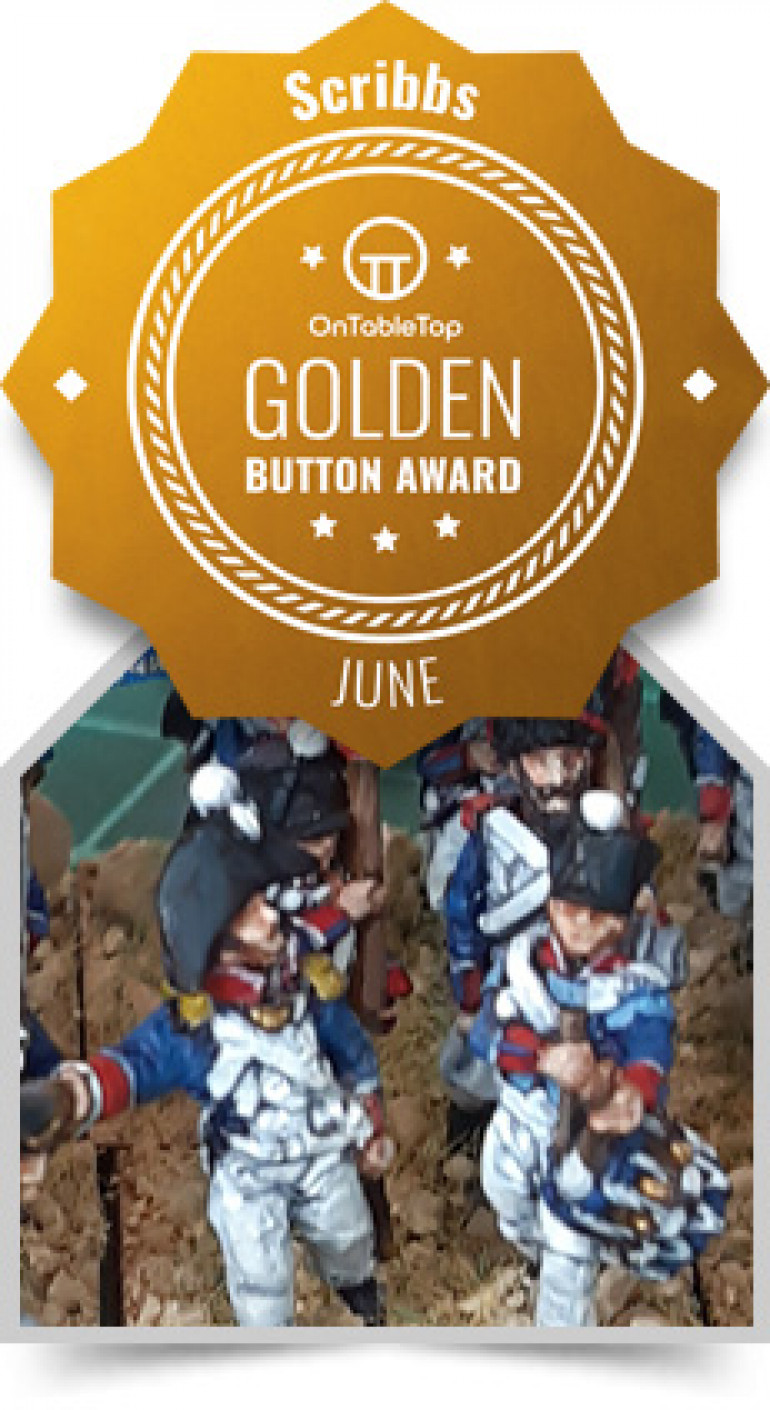 A quick thank you for the Golden Button. Hearing positive comments and seeing recommendations are really appreciated and help keep motivation high.
A quick thank you for the Golden Button. Hearing positive comments and seeing recommendations are really appreciated and help keep motivation high.A small note on some of the details seen in the last two posts for anyone new to Napoleonics. After 1808, Napoleon reorganised the structure of the Grand Armee. From that point onwards, each battalion was formed of six companies, and totaled 840 men (although battalions were rarely at full strength due to casualties and recruitment issues). For Line Infantry, two companies were the elites, the Grenadiers and the Voltigeurs. Also called flank companies, these formed at the right and left ends of the battalion respectively when formed in line.
The other four companies were composed of Fusiliers, with each company identified by a different coloured pom pom. 1st company had dark green, 2nd company sky blue, 3rd company orange, and 4th company violet. With the way I base my battalions, 1st company is usually represented by the command stand.
Some sources state that the 2nd battalions often unofficially had a white dot at the centre of the pom pom. I decided not to add that detail here, but might on another battalion later.
The drummer here has sky blue details. This was something specific to the 45eme that I picked out from browsing through images from a re-enactment group. Most French line infantry regiments had drummers dressed as per the fusiliers, but with orange, green or tricolour coloured piping. In 1810 drummer uniforms changed to a green jacket with white facing and red piping. This didn’t see full adoption until 1812.
1/45e Regiment de Ligne
Fusiliers and command group finished, which when added to the previously painted grenadiers and voltigeurs, completes my first French line infantry battalion.
This is the first battalion of the 45eme Regiment, with the second battalion to follow in due course.
The 45e Regiment were an ever present part of the Grande Armee, having served from Valmy in 1792 up to Waterloo in 1815, and fought in numerous battles all across Europe. They were ordered to Spain in 1808, with the 1st battalion participating in many battles against the British and Spanish, including Talevera, Vittoria and Toulouse. At the latter they held a redoubt against fierce opposition, and only had 100 combat capable men left when they retired from the field.
All models are by Xan. The flag is from Maverick-Models.com, which has a huge range of flags for Napoleonic and other eras. They will adjust flag sizes on request too, which is extremely handy.
Voltigeurs
A small swarm of French Voltigeurs, represented the skirmish bases and formed companies for two line infantry battalions.
There’s a fair bit of variation between regiments in the distinctive yellow and/or green colours of the Voltigeurs. This lot are going to be the 45eme Regiment d’Infanterie de Ligne, who I believed had yellow bands around their shako tops plus yellow and green plumes. I could be entirely wrong, but I like the end result.
All the models are by Xan.
Vive l'Empereur!
After a little pause over April whilst I concentrated on some other projects, I made a start on my French infantry. I decided to lump two line infantry battalions together, and split out the different troop types into batches. This was done with a view to helping me learn the differences in the details and colours that distinguish grenadiers from voltigeurs and fusiliers.
Grenadiers were first up, with a swarm of Voltigeurs next on the paint desk.





























![How To Paint Moonstone’s Nanny | Goblin King Games [7 Days Early Access]](https://images.beastsofwar.com/2024/12/3CU-Gobin-King-Games-Moonstone-Shades-Nanny-coverimage-225-127.jpg)












